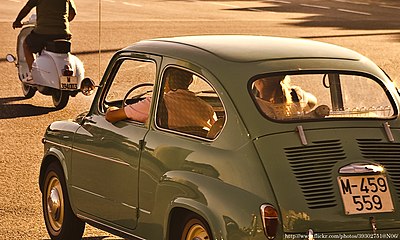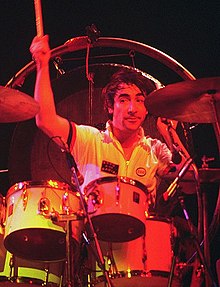The 1960s Portal
The 1960s became synonymous with the new, radical, and subversive events and trends of the period. In Africa the 1960s was a period of radical political change as 32 countries gained independence from their European colonial rulers. Some commentators have seen in this era a classical Jungian nightmare cycle, where a rigid culture, unable to contain the demands for greater individual freedom, broke free of the social constraints of the previous age through extreme deviation from the norm. Christopher Booker charts the rise, success, fall/nightmare and explosion in the London scene of the 1960s. However, this alone does not explain the mass nature of the phenomenon. Several nations such as the U.S., France, Germany and Britain turned to the left in the early and mid 1960s. In the United States, John F. Kennedy, a Keynesian and staunch anti-communist, pushed for social reforms. His assassination in 1963 was a stunning shock. Liberal reforms were finally passed under Lyndon B. Johnson including civil rights for African Americans and healthcare for the elderly and the poor. Despite his large-scale Great Society programs, Johnson was increasingly reviled by the New Left at home and abroad. The heavy-handed American role in the Vietnam War outraged student protestors across the globe, as they found peasant rebellion typified by Ho Chi Minh and Che Guevara more appealing. Italy formed its first left-of-center government in March 1962 with a coalition of Christian Democrats, Social Democrats, and moderate Republicans. Socialists joined the ruling block in December 1963. In Britain, the Labour Party gained power in 1964. In Brazil, João Goulart became president after Jânio Quadros resigned. This is a Featured article, which represents some of the best content on English Wikipedia..
The 1964 European Nations' Cup Final was a football match at the Santiago Bernabéu Stadium, Madrid, on 21 June 1964, to determine the winner of the 1964 European Nations' Cup. It was the second final of what is now called the UEFA European Football Championship, UEFA's quadrennial football competition for national teams. The match was contested by Spain and the previous tournament winners, the Soviet Union. En route to the final, Spain defeated Romania, Northern Ireland and the Republic of Ireland over two-legged ties before beating Hungary in the semi-final. The Soviet Union received a bye in the qualifying round before beating Italy, Sweden and Denmark en route to the final. The referee for the final, played in front of an attendance of 79,115 spectators, was Arthur Holland from England. In the sixth minute, Marcelino dispossessed Valentin Ivanov and crossed for Chus Pereda, who scored to give Spain a 1–0 lead. Two minutes later, Viktor Anichkin passed to Galimzyan Khusainov, who equalised. With six minutes of the match remaining, Pereda beat Anichkin and played in a cross which Viktor Shustikov failed to clear, before Marcelino headed the winning goal inside the near post. Spain won the match 2–1 to win their first European Championship title. (Full article...)This is a Good article, an article that meets a core set of high editorial standards.
 The 1960 Atlantic hurricane season was the least active season since 1952. The season officially began on June 15, and lasted until November 15. These dates conventionally delimit the period of each year when most tropical cyclones form in the Atlantic basin. The first system, an unnamed storm, developed in the Bay of Campeche on June 22. It brought severe local flooding to southeastern Texas and was considered the worst disaster in some towns since a Hurricane in 1945. The unnamed storm moved across the United States for almost a week before dissipating on June 29. In July, Hurricane Abby resulted in minor damage in the Leeward Islands, before impacting a few Central American counties — the remnants of the storm would go on to form Hurricane Celeste in the East Pacific. Later that month, Tropical Storm Brenda caused flooding across much of the East Coast of the United States. The next storm, Hurricane Cleo, caused no known impact, despite its close proximity to land. The most significant storm of the season was Hurricane Donna, which at the time was among the ten costliest United States hurricanes. After the precursor caused a deadly plane crash in Senegal, the storm itself brought severe flooding and wind impacts to the Lesser Antilles and Florida, where Donna made landfall as a Category 4 hurricane. It moved northeast and struck North Carolina and Long Island, New York, while still at hurricane intensity. Donna caused at least 428 fatalities and $980 million (1960 USD) in damage. Hurricane Ethel reached Category 3 intensity, but rapidly weakened before making landfall in Mississippi, resulting in only 1 fatality and $1.5 million in losses. The final storm, Florence, developed on September 17. It remained weakened and moved erratically over Cuba and Florida. Only minor flooding was reported. Collectively, the tropical cyclones in 1960 caused at least 454 deaths and about $990.74 million in damage. (Full article...)Selected picture -Did you know -
Related portalsThis is a Featured article, which represents some of the best content on English Wikipedia..
Walter Elias Disney (/ˈdɪzni/; December 5, 1901 – December 15, 1966) was an American animator, film producer, and entrepreneur. A pioneer of the American animation industry, he introduced several developments in the production of cartoons. As a film producer, he holds the record for most Academy Awards earned and nominations by an individual. He was presented with two Golden Globe Special Achievement Awards and an Emmy Award, among other honors. Several of his films are included in the National Film Registry by the Library of Congress and have also been named as some of the greatest films ever by the American Film Institute. Born in Chicago in 1901, Disney developed an early interest in drawing. He took art classes as a boy and took a job as a commercial illustrator at the age of 18. He moved to California in the early 1920s and set up the Disney Brothers Studio (now The Walt Disney Company) with his brother Roy. With Ub Iwerks, he developed the character Mickey Mouse in 1928, his first highly popular success; he also provided the voice for his creation in the early years. As the studio grew, he became more adventurous, introducing synchronized sound, full-color three-strip Technicolor, feature-length cartoons and technical developments in cameras. The results, seen in features such as Snow White and the Seven Dwarfs (1937), Pinocchio, Fantasia (both 1940), Dumbo (1941), and Bambi (1942), furthered the development of animated film. New animated and live-action films followed after World War II, including the critically successful Cinderella (1950), Sleeping Beauty (1959) and Mary Poppins (1964), the last of which received five Academy Awards. (Full article...)This is a Good article, an article that meets a core set of high editorial standards.
Keith John Moon (23 August 1946 – 7 September 1978) was an English musician who was the drummer for the rock band the Who. Regarded as one of the greatest drummers in the history of rock music, he was noted for his unique style of playing and his eccentric, often self-destructive behaviour. Moon grew up in Wembley and took up the drums during the early 1960s. After playing with a local band, the Beachcombers, he joined the Who in 1964 before they recorded their first single. Moon was recognised for his drumming style, which emphasised tom-toms, cymbal crashes, and drum fills. Throughout his tenure with the Who, his drum kit steadily grew in size, and (along with Ginger Baker) he has been credited as one of the earliest rock drummers to regularly employ double bass drums in his setup. Moon occasionally collaborated with other musicians and later appeared in films, but considered playing in the Who his primary occupation, and remained a member of the band until his death. In addition to his talent as a drummer, Moon developed a reputation for smashing his kit on stage and destroying hotel rooms on tour. He was fascinated with blowing up toilets with cherry bombs or dynamite, and destroying television sets. Moon also enjoyed touring and socialising, and became bored and restless when the Who were inactive. His 21st birthday party in Flint, Michigan, has been cited as a notorious example of decadent behaviour by rock groups. (Full article...)Selected article -Second-wave feminism was a period of feminist activity that began in the early 1960s and lasted roughly two decades, ending with the feminist sex wars in the early 1980s and being replaced by third-wave feminism in the early 1990s. It occurred throughout the Western world and aimed to increase women's equality by building on the feminist gains of the late 19th and early 20th centuries. Second-wave feminism built on first-wave feminism and broadened the scope of debate to include a wider range of issues: sexuality, family, domesticity, the workplace, reproductive rights, de facto inequalities, and official legal inequalities. It was a movement focused on critiquing patriarchal or male-dominated institutions and cultural practices throughout society. Second-wave feminism also brought attention to issues of domestic violence and marital rape, created rape crisis centers and women's shelters, and brought about changes in custody law and divorce law. Feminist-owned bookstores, credit unions, and restaurants were among the key meeting spaces and economic engines of the movement. (Full article...)More Did you know (auto generated)
TopicsCategoriesWikiProjects
Associated WikimediaThe following Wikimedia Foundation sister projects provide more on this subject:
Discover Wikipedia using portals |




























